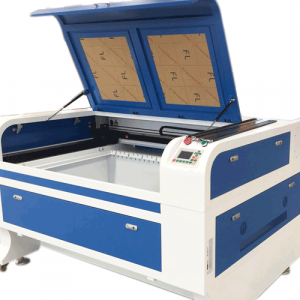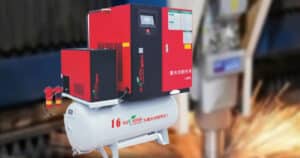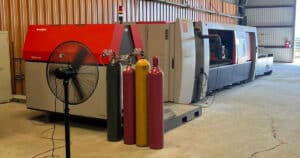This article mainly describes the principle of laser cutting technology, highlights several mainstream laser cutting technologies, and analyzes the current status and future development of laser cutting technology.
Laser processing technology is an advanced manufacturing technology, and laser cutting is a part of laser processing applications.
Laser cutting is currently the world’s most advanced cutting technology.
Because it has the advantages of precision manufacturing, flexible cutting, special-shaped processing, one-time forming, high speed, and high efficiency, it solves many problems that conventional methods in industrial production cannot.
Lasers cut most metallic and non-metallic materials.
Overview
Laser cutting technology mainly uses a high-power density laser beam to irradiate the cut material, obtaining a power density of more than 104 W/mm2 at the focus of the beam so that the material is quickly heated to vaporization temperature and evaporates to form a hole. With the movement of the beam to the material, the hole continuously forms a narrow width (such as 0.1mm or so) slit to complete the cutting of the material.
Laser cutting can be divided into three types: laser vaporization cutting, laser melting cutting, laser oxygen cutting, and laser slicing and controlling fracture.
In addition to the supporting components, moving parts, and corresponding motion control devices needed by general machine tools, laser cutting equipment should also be equipped with a laser processing system, which is composed of a laser, focusing system, and electrical system.
Characteristics of laser cutting technology
Compared with other traditional cutting methods, laser cutting technology has many advantages, which are summarized as follows:
- The cutting gap is narrow and has good cutting accuracy.
- Fast cutting speed and small heat-affected zone.
- The laser cutting surface is of good quality, the cutting edge is vertical, the cutting edge is smooth, and the welding can be carried out directly without correction.
- The cutting edge has no mechanical stress and does not produce a shear burr and chip.
- In laser cutting, there is no tool loss or contact energy loss, and there is no need to replace the tool.
- Laser cutting can easily cut hard and brittle materials such as glass, ceramics, PCD composites, and semiconductors, as well as soft and elastic materials such as plastics and rubber.
- The beam has no inertia and can be cut at high speed.
- Using the laser’s characteristics, multi-station operation and numerical control automation can be easily realized.
Laser cutting method
Laser vaporization cutting
Gasification cutting requires a high power density (more than 106W/mm2); in such a high power density laser beam irradiation, the temperature on the surface of the material instantly rises above the boiling point so that part of the material becomes a steam escape. Part of the material soon becomes ejecta from the bottom of the cutting seam and is blown away to form a slit or narrow groove; this method is mainly used for non-melting materials, such as wood, paper, carbon, and some organic cutting.
The vaporization cutting process is as follows: when the laser beam irradiates on the workpiece surface, part of the beam energy is reflected, and the rest energy is processed and absorbed, and the reflectivity decreases sharply with the continuous heating of the material surface, while the absorptivity increases rapidly. this is due to the oxidation caused by the increase of material surface temperature, which changes the electronic structure of the surface layer, and the shape of the material surface is changed due to the deformation caused by thermomechanical stress.
Subsequently, the voids with the blackbody effect are formed by vaporization and the comprehensive results of the dissociation of vapor on the material surface into a plasma layer.
This process is carried out so quickly that it can be expressed in a formula:
μ = Ae-B/t.
μ-absorption coefficient.
A B-experimental constant.
T-laser action time.
Melting cutting
The basic process of melting cutting is that when the power density of the incident laser beam exceeds a certain threshold, evaporation will occur in the material.
The hole is formed because the blackbody effect hole will absorb all the incident beam energy. The hole is surrounded by the molten metal wall, which relies on the high-speed steam flow to keep the melt wall relatively stable and forms a melting isotherm that runs through the processed material. Then, the molten material around the hole is blown out and removed by the injection pressure of the auxiliary airflow coaxial with the beam when the processed material moves according to the track required by the processing.
The keyhole translates and forms a slit, and the laser beam continues to irradiate along the front of the seam with the movement of the machined material. The molten material is blown away continuously or publically by the auxiliary gas, forming the cutting of the melting mechanism.
The laser beam power density required for melting cutting is about 107W/cm2.
Oxygen-assisted melting cutting
Oxygen-assisted melting cutting uses oxygen or other active gas as auxiliary gas to replace the inert gas used in melting cutting.
Due to the ignition of the thermal matrix, another heat source coexisting with laser energy is produced. Oxygen-assisted melting cutting is another kind of laser cutting method derived from melting cutting, and its mechanism is complicated. The basic cutting process is that the surface of the material reaches the ignition temperature instantly under the irradiation of the laser beam, followed by contact with oxygen, a fierce combustion reaction occurs, and a large amount of heat is released. Under the action of this heat, a small hole full of steam is formed inside the material. The hole is surrounded by the molten metal wall, and the surrounding molten metal wall moves forward due to the movement of the stream flow, and the heat and matter transfer occurs. The transfer of combustion material to slag controls the combustion rate of oxygen and metal, and the speed of oxygen diffusion to the ignition front through the slag also has a great influence on the combustion speed. The faster the oxygen flow rate is, the faster the combustion chemical reaction and material removal rate is. In addition, the oxides produced by the chemical reaction at the slit outlet are cooled rapidly. In the area where the ignition temperature is not reached, oxygen acts as a condenser to reduce the heat-affected zone.
In oxygen-assisted melting cutting, there are two heating sources: laser irradiation energy and oxygen-metal exothermic reaction energy. The laser cutting speed diagrams of stainless steel and titanium are shown, respectively.
Laser cutting using oxygen as an auxiliary gas can achieve a higher cutting speed than using inert gas.
Control fracture cutting
Controlled fracture cutting is the use of a laser beam to heat brittle materials, which are easy to be damaged by heat so that they can be cut off at high speed and controllably. The cutting process of this method can be summarized as follows: when the laser beam heats a small area on the surface of the brittle material, the material produces an obvious temperature ladder after heating, and the higher surface temperature of the material will expand, while the lower temperature of the inner layer of the material will prevent its expansion. as a result, the inner layer produces radial extrusion stress, and the surface layer produces tensile stress relative to the inner layer, causing serious mechanical deformation. Because the compressive strength of the brittle material is much higher than the tensile strength, the material will crack from the inside first. Because the maximum mechanical deformation occurs in the heating area of the laser beam, as long as a balanced heating gradient is maintained, the laser beam can guide the crack to generate and extend in any desired direction. It should be noted that this cutting machine is not suitable for cutting acute angles and edge seams, nor is it suitable for cutting workpieces with extra closed shapes.
What are the Factors for Cutting Performance?
A remarkable feature of laser cutting is that the main parameters that affect the machining quality can be highly effectively controlled, so the effect of the laser cutting workpiece can meet the requirements of practical application and has good repeatability.
In order to achieve a good quality laser cutting with a clear outline, narrow slit, minimum thermal damage, good parallelism, no cutting slag, and high cutting surface finish, it is necessary to understand and control the factors that have a great influence on laser cutting.
Influence of beam characteristics on laser cutting quality.
The influence of beam mode
The energy distribution in the cross-section of the laser beam is called mode (also known as a mode) and is expressed by TEM.
The beam mode is related to its focusing ability. The lowest mode is called TEM00, and the energy in the spot is distributed in a Gaussian curve. Beams with this mode can focus on the theoretically smallest spot size, with a diameter of a few millimeters, and give the steepest and sharpest high energy density. The energy distribution of the high-order mode or multimode beam is relatively expanded, and the focused spot size is larger, but the energy density is lower.
Compared with the low-order mode-excited beam with the same power input, it is not as sharp as it is.
Because of its relatively small spot and high power density, the cutting of the fundamental mode laser beam can obtain a narrow slit, straight cutting edge, and little hot zone influence.
The remelting layer in the cutting area is also the thinnest, and the degree of slag sticking on the bottom surface is the lightest, even non-sticky slag.
In the actual cutting process, the best spot size should be determined according to the thickness of the material to be cut.
If the same output power laser beam is used to cut the steel plate, the thicker the steel plate is, the larger the laser beam spot size should be in order to obtain better cutting quality.
The influence of focus spot and focus position
The diameter of the focusing spot D can be calculated by the formula:
Dao 2.4F λ.
The spot diameter when the D-power intensity decreases to the central value of 1/e2, μ m.
The optical system coefficient used by F-is equal to the focal length of the lens / the diameter of the incident beam for a biconvex mirror.
The Zs are associated with the spot size, which represents the distance between the focus and the center of the optical axis where the power intensity exceeds the peak intensity 1 to 2, which can be calculated by a formula:
λ-wavelength.
The focal length of L-lens.
A-spot radius.
F-coefficient, F=L/ (2a).
The formula shows that the spot size of the focused laser beam is proportional to the focal length of the lens, and the selection of the F value should be matched with the properties, thickness, and laser power of the workpiece material.
The shorter the focal length of the focus lens, the smaller the F value, the smaller the spot size and focal depth, and the higher the power density at the focus, the more favorable it is for material cutting; however, the disadvantageous factor brought by the focal depth is to adjust the margin, which is generally suitable for cutting thin materials at high speed.
For the workpiece with a larger thickness, the long focal length lens with a larger focal depth can meet the processing requirements as long as it has sufficient laser power density.
The following figure shows the relationship between the focal length, the focal depth, and the spot size of the lens. As the focal length increases, the focal spot becomes larger, and the focal depth becomes longer.
When the lens’s focal length is increased, and the spot size doubles (from Y to 2Y), the focal depth increases fourfold (from X to 4X).
After the F value is determined, because the focus is at the highest laser power density, in most cases, the position of the cutting focus is on the surface of the workpiece or slightly below the surface.
In laser cutting, the best focus position produces the smallest cutting seam and the highest efficiency.
The effect of beam polarization
Almost all the high-power lasers used for laser cutting have the property of plane polarization. Like any form of electromagnetic wave transmission, the laser beam also has electrical and magnetic sub-vectors that are perpendicular to each other and 90 °with the beam direction. During the cutting process, the beam is constantly reflected on the cutting surface. Due to the beam polarization, the ability of the cut material to absorb the beam is greatly affected when the cutting direction is different.
The changes in slit width, cutting edge roughness, and verticality are all related to beam polarization.
When a certain deflection angle is formed between the running direction of the cutting and the polarization direction of the beam, the energy absorption of the cut material is reduced, the cutting speed is reduced, and the cutting seam becomes wider, the cutting edge becomes rough, and the cutting edge is not straight and inclined; when the cutting direction is completely perpendicular to the polarization direction of the beam, the slope of the cutting edge disappears, the cutting speed is slower, the cutting edge is wider, and the cutting quality is rougher.
For a workpiece with a complex shape, it is necessary to take measures to control the beam to form circular polarization in order to obtain a uniform and high-quality slit.
At present, the common practice is that the beam emitted by the laser cavity passes through a special lens called a circular polarizer before focusing, and the linearly polarized beam is converted into a circularly polarized beam, thus avoiding all kinds of adverse effects of the linearly polarized beam on the cutting quality. even in the state of high-speed cutting, the cutting quality of the circularly polarized beam can be kept consistent in all directions.
The phenomenon that the cutting angle at the bottom of the cutting seam deviates from the cutting direction by 90 is eliminated.
Laser cutting speed on laser cutting quality
The basis of laser cutting depends on the effective beam power density and the physical properties of the cut material.
The cutting speed of the material is directly proportional to the effective laser power density and inversely proportional to the material density and thickness.
The influence of cutting speed on cutting quality is very obvious.
When the cutting speed is too low because the oxygen combustion speed is higher than or equal to the moving speed of the laser beam, there are obvious burn marks on the cutting edge of the workpiece. The cutting seam is wide, and the section is also very rough. The burn degree at the bottom of the cutting edge is more serious than that at the top.
When the cutting speed gradually increases into a certain range, although the moving speed of the laser beam changes, the width of the slit basically tends to be stable, the parallelism of the cutting edge is good, and the section is regular fine stripes.
Laser cutting usually works in this range, beyond this range, continues to improve the cutting speed, due to the lack of light beam reflected inside the slit, the material can not be cut through.
This kind of trimming section is diagonally striped at a certain angle, and the molten slag is difficult to discharge smoothly from the bottom, so the heat-affected zone is obviously enlarged.
The parallel edge of the cutting seam is destroyed to form a wedge-shaped edge so that the slag can not be discharged before solidification, and the cutting is a complete failure.
Laser cutting of different materials
Laser cutting of carbon steel
The maximum thickness of a carbon steel plate cut by a modern laser cutting system has reached 20mmy. Oxygen-assisted melting cutting can control the cutting width of a carbon steel plate within the required range, and the cutting seam can reach about 0.1mm when cutting a thin plate.
The heat-affected zone in the cutting process is very small, and the steel with low carbon content can almost be ignored.
The cutting seam of laser-cut carbon steel is smooth, the cutting surface is clean and smooth, and the cutting edge is vertically straight.
The segregation zone of phosphorus and sulfur in low-carbon steel causes edge erosion and leads to a decline in cutting quality.
Therefore, the edge-cutting quality of high-quality cold-rolled steel plate with low impurity is better than that of hot-rolled steel plate.
When laser cutting carbon steel with high carbon content, the edge-cutting quality is slightly improved, but the heat-affected zone is also enlarged.
When laser cutting galvanized or plastic-coated thin steel plate (thickness 0.5~2.0mm), it has high cutting efficiency, narrow slit and saves material, and will not cause deformation.
The heat-affected zone near the slit is small, and the galvanized layer or plastic coating in the slit area will not be damaged.
Laser cutting of stainless steel
The cutting property of stainless steel is similar to that of low-carbon steel. High cutting quality can not be obtained at low cutting speed, and the fine cutting speed range becomes wider with the increase of laser power.
The difference is that stainless steel cutting requires higher laser power and greater oxygen pressure.
Moreover, although stainless steel can achieve a satisfactory cutting effect, it is difficult to obtain a completely slag-free cutting seam.
Laser cutting stainless steel sheet is a very effective processing method. By strictly controlling the heat input in the cutting process, the heat-affected zone of edge cutting can be reduced to very small, ensuring that the good corrosion resistance of stainless steel material will not be destroyed.
There are three kinds of stainless steel commonly used: austenitic stainless steel (such as 1Cr18Ni9Ti), martensitic stainless steel (such as Cr13), and Ferritic stainless steel (such as Cr18).
Austenitic stainless steel contains nickel, which affects the coupling and transmission of laser beam energy in the material.
The viscosity of molten nickel is high, especially during cutting, and the slag will adhere to the back of the cutting, which is more obvious for the workpiece with a larger thickness.
There is no nickel in martensitic stainless steel and Ferritic stainless steel, and clean and smooth edge cutting quality can be obtained by laser cutting.
Laser cutting of alloy steel
Good trimming quality can be obtained by laser cutting most alloy structural steel and alloy tool steel.
For example, when the laser power is 1.7kW, and the cutting speed is 1.2m/min, the slit without sticking slag can be obtained by cutting 6mm thick tool steel and manganese steel. By measuring the hardness, it can be inferred that the HAZ of manganese steel cutting is less than 0.6mm, the hardness increment after cutting is similar to that of mechanical shearing, the HAZ of tool steel is within 0.3mm, and the maximum hardness value is 800HV.
Laser cutting of CrN and CrNi-Mo-alloy structural steel can also produce a high-quality, clean, straight cutting edge.
However, the phenomena of erosion and slag sticking occur during laser cutting of tungsten-containing high-speed steel and heat-obtained steel.
10,000-watt laser cutting machines can cut aluminum alloy plates up to 50mm and stainless steel plates up to 60mm. With the introduction of 12kW and 15kW optical fiber laser cutting machines, the thickness limit of material cutting will continue to be broken.
The data show that for 8mm stainless steel, the speed of a 6KW laser cutting machine is nearly 400% higher than that of a 3KW machine.
In terms of 20mm thick stainless steel, the speed of 12KW is 114% faster than that of 10KW.
Here is the technology parameters of MAX LASER SOURCE :
| OPTICAL SPECIFICATIONS | ||||
| Nominal Power | 6000W | 12000W | 15000W | 20000W |
| Mode of Operation | CW/Modulated | |||
| Polarization | Random | |||
| Power Tunability | 10 to 100% | |||
| Wavelength | 1080 ± 5 nm | |||
| Power Stability | ±1 % | |||
| Laser Beam Quality, BPP | 3.5 to 4.5 mm x mrad (100μmQBH) | |||
| 5 to 6.5 mm x mrad (150μmQBH) | ||||
| 6.5 to 9 mm x mrad (200μmQBH) | ||||
| Modulation Frequency | ≤5kHz | |||
| Preview Red Light Power | 200 μW | |||
| FIBER DELIVERY SYSTEM | ||||
| Interface | QBH | LOE | ||
| Length | 20m standard, other lengths optional | |||
| Diameter | 100/150/200 μm | 150/200 μm | ||
| Bending Radius | 200 mm | |||
| ELECTRICAL RATINGS | ||||
| Supply Voltage | 400 (-15% to +10%) VAC 3-phase | |||
| OTHER SPECIFICATIONS | ||||
| Operating Temperature | +10 to +40℃ | |||
| Storage Temperature | -10 to +60℃ | |||
| Humidity | 10 to 80% | |||
| Cooling Method | Water Cooling | |||
| Cooling Medium | Distilled water/ Glycol Antifreeze | |||
| Dimension | 1050×1385×1658 mm | |||
| Weight | 534(±4) kg | 646(±5) kg | 726(±5) kg | 815(±5) kg |
6000W-20000W High Power Multi-Module CW Laser series adopts water cooling and modular design. The compact design, highly integrated system, free of maintenance, high reliability, high beam quality, and high beam stability are the ideal laser sources for laser cutting, laser welding, laser cladding, surface heat treatment, etc. With the fiber laser QBH output head, the laser source can be integrated with the robot or machine tool to do applications in the laser cutting field, new energy, construction machinery, automobile parts, aerospace, etc.







